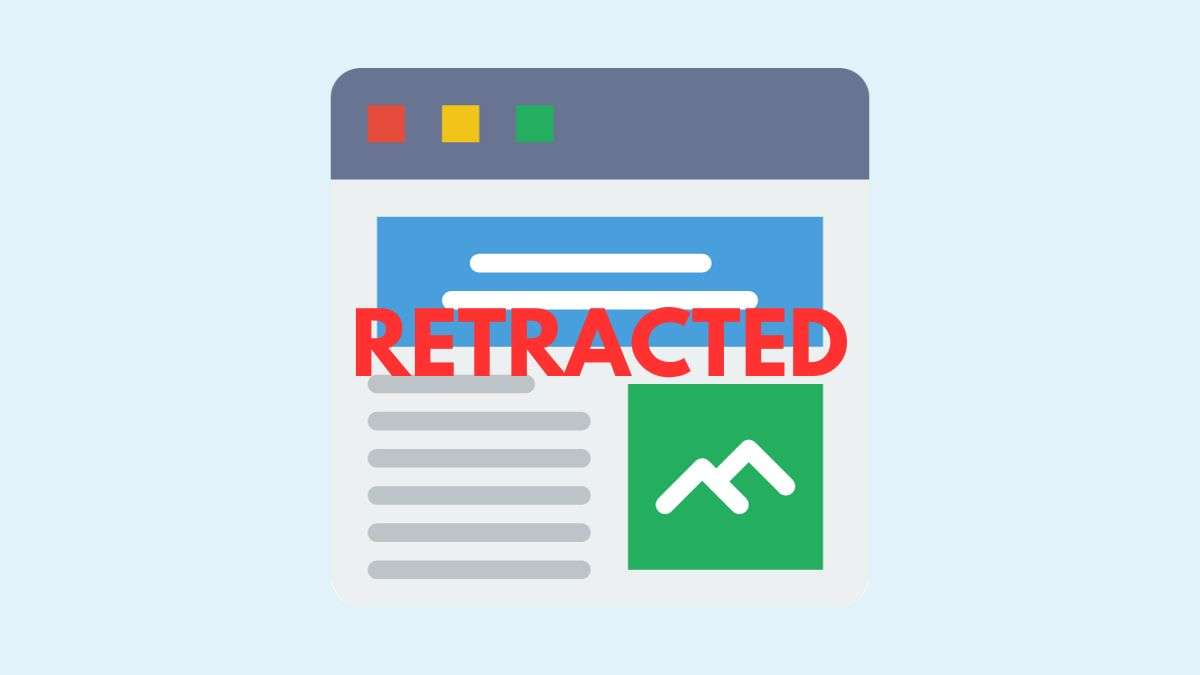Table of Contents
- Introduction
- The Three Common Reasons for Article Retraction
- Why Understanding the Reasons is Important
- Examining the Process of Article Retraction
- Guidelines for Retraction and Policies
- Conclusion
Introduction
The write-up discusses common reasons for article retraction, an essential issue in academic publishing that warrants close examination. When articles are retracted, it can significantly impact scientific knowledge and public trust. Understanding why articles get retracted and addressing the root causes is vital to upholding research integrity.
Article retraction is the formal withdrawal of a published paper by the authors or the journal editor. It is done when issues fundamentally undermine the paper’s findings, such as data fabrication, plagiarism, or unethical research practices. Though infrequent, retractions can have a disproportionate effect by calling into question the validity of research.
Identifying Common Reasons for Article Retraction
The retraction of flawed articles can shake confidence in academic research and science. High-profile retractions involving misconduct or data integrity loss can receive substantial media coverage, fueling public skepticism. This may impact funding decisions and policies based on discredited research. Retractions also create extra work for scientists to verify or redo studies.
Understanding what issues commonly trigger article retractions enables the research community to address them proactively. Causes may include ethical violations, unreliable data, plagiarism, authorship disputes, etc. Academic institutions can implement training on research integrity, and journals can refine screening criteria and checks. Addressing recurring issues supports accurate, honest science that the public can trust.
The Three Common Reasons for Article Retraction
Plagiarism and self-plagiarism are two of the most common reasons for article retraction. When authors fail to properly cite sources or reuse significant portions of their own previously published work without attribution, it undermines the integrity of the research. These ethical violations can damage an author’s reputation and credibility.
Another prevalent cause of retractions is data fabrication or falsification. Researchers manipulating or fake data to achieve desired outcomes invalidates the entire study. The revelation of such ethical breaches rightfully calls the underlying research into question and typically results in a retraction.
Other ethical issues can also prompt article retraction, such as duplicate submission, authorship disputes, failure to disclose conflicts of interest, etc. Violating ethical codes erodes public and peer trust in science. Understanding the range of violations that commonly lead to retraction can help reinforce the importance of integrity in research. Let’s examine these common reasons for article retraction in the subsequent section.
1. Plagiarism and Self-plagiarism
Plagiarism involves failing to attribute or cite content copied from other sources correctly. Self-plagiarism refers to authors reusing their previously published work excessively without disclosing it. Both constitute ethical violations in academic publishing.
When plagiarism or self-plagiarism is exposed, it often results in article retraction. Such ethical breaches damage an author’s reputation and the credibility of their work. Retraction officially withdraws the invalid research from the accepted body of scientific literature.
2. Data Fabrication and Falsification
Another common factor behind article retractions is data fabrication or falsification. This occurs when researchers manipulate or fake data to achieve desired outcomes and portray more significant findings.
Once detected, such ethical violations invalidate the entire study. Data represents the foundation of research. When that underlying data is fabricated, the research loses integrity and credibility, warranting retraction from the scientific record.
3. Ethical Violations
Other ethical breaches can also prompt article retraction, though they may be less common than plagiarism or data fabrication.
For example, duplicate submission—attempting to republish findings in another journal without disclosure—violates publication ethics. Authorship disputes, failing to reveal financial conflicts of interest, or not obtaining proper patient consent also constitute ethical issues that damage credibility and trust in science.
While less frequent, revelations regarding such ethical violations often necessitate article retraction to uphold standards and integrity in academic publishing.
Why Understanding the Reasons is Important
Identifying and understanding the common reasons for article retraction is crucial.
Retracted articles can have severe implications for the reputation and credibility of researchers. When an article is retracted due to falsification, fabrication, or plagiarism, it calls into question the integrity of the authors. This can damage their standing in the scientific community and make it harder for them to secure funding or publish future research. Even unintentional errors leading to retraction can hurt a researcher’s perceived reliability.
The discovery of intentional misconduct is incredibly damaging. High-profile data falsification or plagiarism cases receive media attention, and this publicity can spread distrust of science more broadly. Researchers may find it harder to get hired or win grants if they have a retraction on their record. So, understanding the common causes of retractions is key to preserving scientific integrity.
Retractions also influence funding agencies and policymakers. There can be significant fallout if retracted studies have helped secure major grants or informed regulations. Public trust in science may decline as well. All of this underscores the need for robust research practices to prevent retractions from happening in the first place.
Many retractions can be avoided if researchers adhere to sound scientific methods and ethical norms. Thorough peer review, sharing data openly, disclosing conflicts of interest, and careful study design and analysis will reduce errors and misconduct. Training in research ethics is essential. So are institutional oversight and accountability procedures. With concerted efforts across academia to bolster scientific integrity, the overall rate of article retractions can be substantially reduced.
Examining the Process of Article Retraction
The role of journal editors and peer reviewers is crucial in identifying issues that may warrant article retraction. As gatekeepers of academic publishing, editors and reviewers have an ethical responsibility to thoroughly scrutinize submissions, looking for signs of plagiarism, data fabrication, ethical violations, or other problems.
If any issues arise, the editors should investigate further and contact the authors and their affiliated institutions. Depending on the severity and intent of the misconduct, the editors may then decide to retract the published article.
There are several legal and ethical considerations involved in retracting an article. Publishers must balance concerns over credibility and integrity with an author’s right to due process. Formal retraction policies outline procedures for conducting investigations, notifying authors, allowing them to respond to allegations, issuing retractions, and preserving the public record.
Considerations around authorship disputes, industry regulations, privacy, and the reproducibility crisis may further complicate matters. Ultimately, the decision to retract should be governed by honesty, accountability, and transparency principles.
Editors and publishers must communicate article retractions and the reasons behind them to all affected parties. They should notify readers and the scientific community by publishing a retraction notice on the article and relevant indexes and databases. Press releases, website postings, and direct emails to citing authors also help spread the word.
Retraction notices should provide details on the reason for the retraction and who initiated it. By adequately documenting retractions, publishers enable researchers to adjust literature reviews, meta-analyses, and policy recommendations accordingly.
Guidelines for Retraction and Policies
Various organizations and publishers have established guidelines on article retraction to maintain the standards of academic publishing. The Committee on Publication Ethics (COPE) is a primary resource. COPE provides comprehensive guidelines that advise editors on handling issues around retraction. According to COPE, retractions are meant to correct the literature and ensure its integrity rather than punish authors for misbehaving. You can also enhance your understanding of the common reasons for article retraction and why the issue keeps cropping.
The guidelines emphasize transparency and communication; the retraction notice should be linked to the retracted article where possible, clearly identify the reason for the retraction, and be freely available to all readers. The goal is not only to inform readers of the retraction but also to discourage misconduct and educate researchers about the consequences of such actions.
Another critical set of guidelines can be found in the policies of individual academic journals and publishers. For example, large publishers like Elsevier, Wiley, and Springer Nature have retraction policies, generally consistent with COPE’s guidelines but may include additional publisher-specific procedures.
The International Committee of Medical Journal Editors (ICMJE) also offers guidance on publication ethics, including article retraction. The ICMJE stresses the importance of maintaining the integrity of the scientific record and outlines the responsibilities of authors, editors, and publishers in this process.
It is worth noting that different disciplines might have variations in retraction practices, reflecting the norms and expectations of their respective research communities. However, across disciplines, the principles of transparency, preserving the scholarly record, and preventing the dissemination of erroneous information remain central to the retraction process.

For specific cases and examples of retraction notices, one can refer to Retraction Watch, a website that tracks retractions as a window into the scientific process. Retraction Watch maintains a database of retracted articles and provides news and analysis on retractions, offering insight into common reasons for article retraction and their impact on the scientific community.
COPE, individual journals’ and publishers’ policies, ICMJE recommendations, and resources like Retraction Watch provide frameworks and insights on the policies and processes surrounding article retraction in academic publishing. These guidelines and resources aim to uphold ethical standards and preserve the integrity of the academic record.
Conclusion
The article has explored some of the most common reasons for article retractions in academic publishing. As discussed, issues like plagiarism, data fabrication, and ethical violations can all undermine the integrity of published research and lead to retractions.
Moving forward, researchers must prioritize ethical conduct and rigor in their work. Academics have a collective duty to uphold the credibility of the scholarly record by adhering to transparency, honesty, and accountability.
Key Summaries
The key summaries around what frequently leads to article retractions include:
- Plagiarism and self-plagiarism remain the leading causes of retraction
- Fabricating or falsifying data also results in many article retractions
- Violating ethical standards is another common trigger for retractions
Identifying and understanding these common issues can help inform efforts to prevent questionable research practices.
Research Integrity
Researchers must uphold the highest ethical and methodological standards when conducting and publishing studies. Some ways to encourage integrity include:
- Emphasizing honesty, accountability, and transparency at every stage of research
- Promoting training around ethical research conduct early in academic careers
- Implementing honor codes and ethics policies at institutions and journals
- Celebrating and rewarding exemplars of research integrity
Fostering a culture where sound, ethical research is valued, and misconduct has consequences can guide researchers’ behavior in the right direction.
Collective Credibility
Upholding credibility ultimately requires a collective effort across the research community. Academia as a whole benefit when integrity standards are upheld. Some final thoughts include:
- Researchers should see themselves as stewards of scientific integrity
- Journals and institutions must enforce policies on ethics and misconduct
- The public’s trust depends on a system committed to transparency and rigor
With shared responsibility across academia, scientific knowledge can continue advancing ethically and benefiting society.
